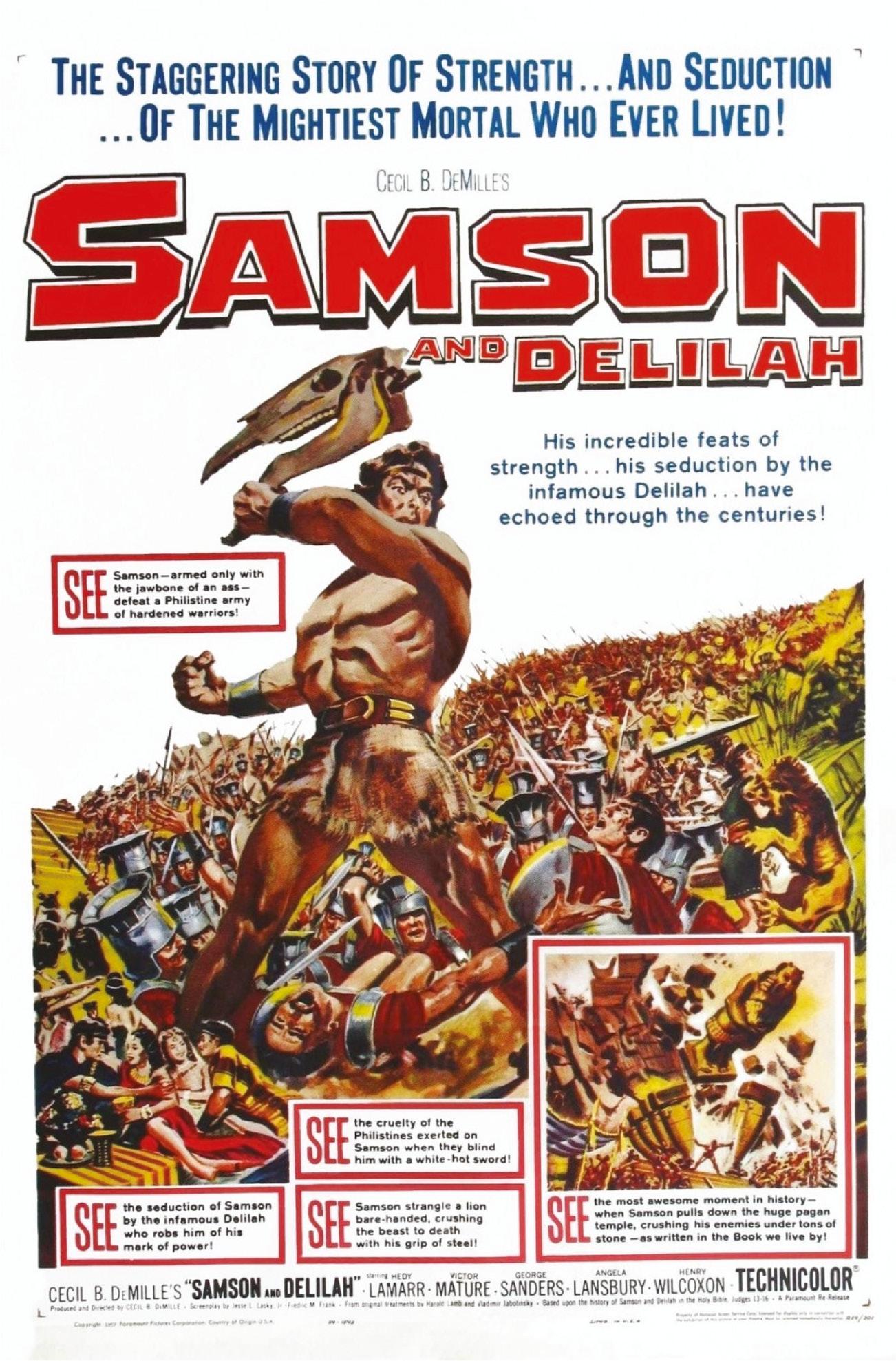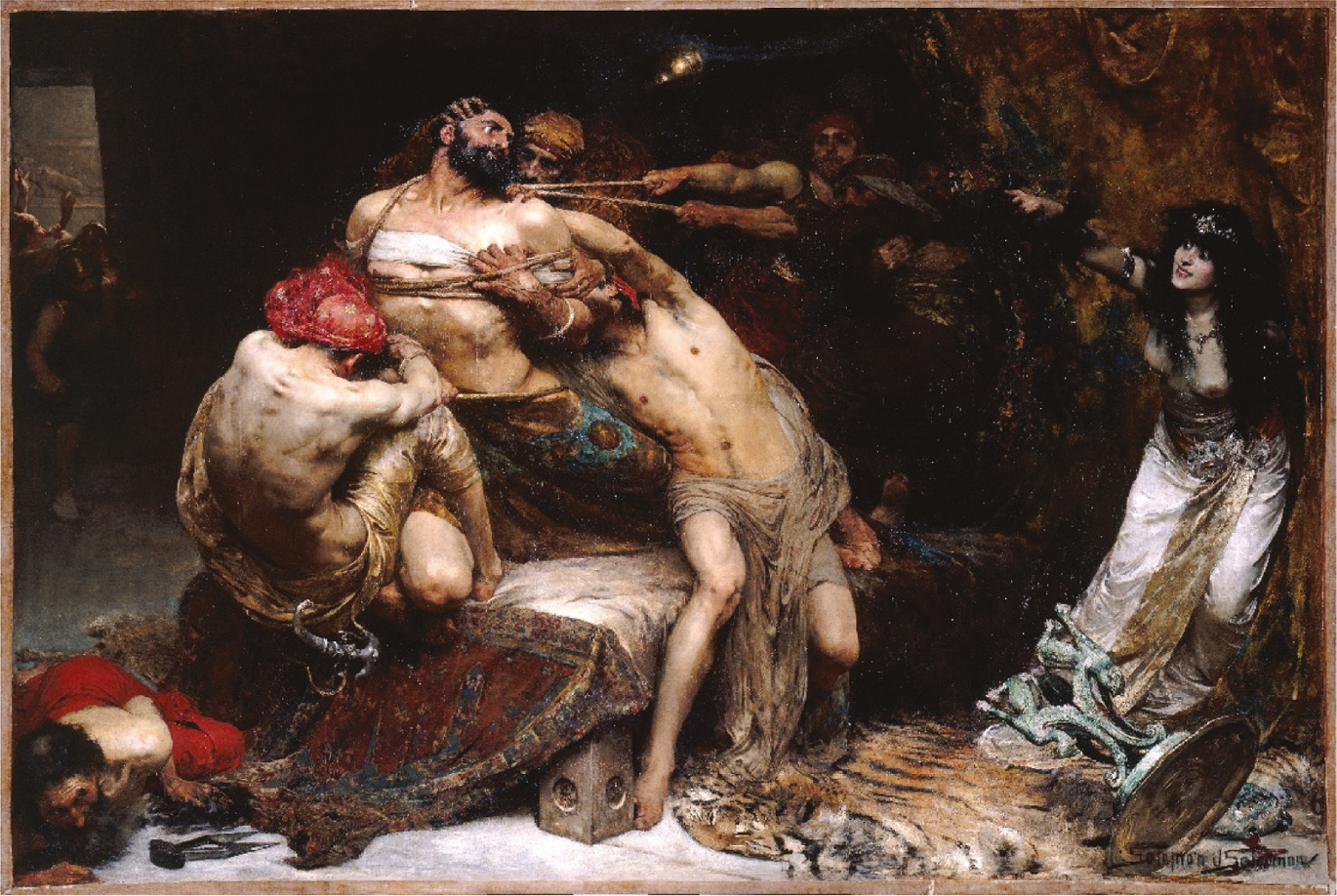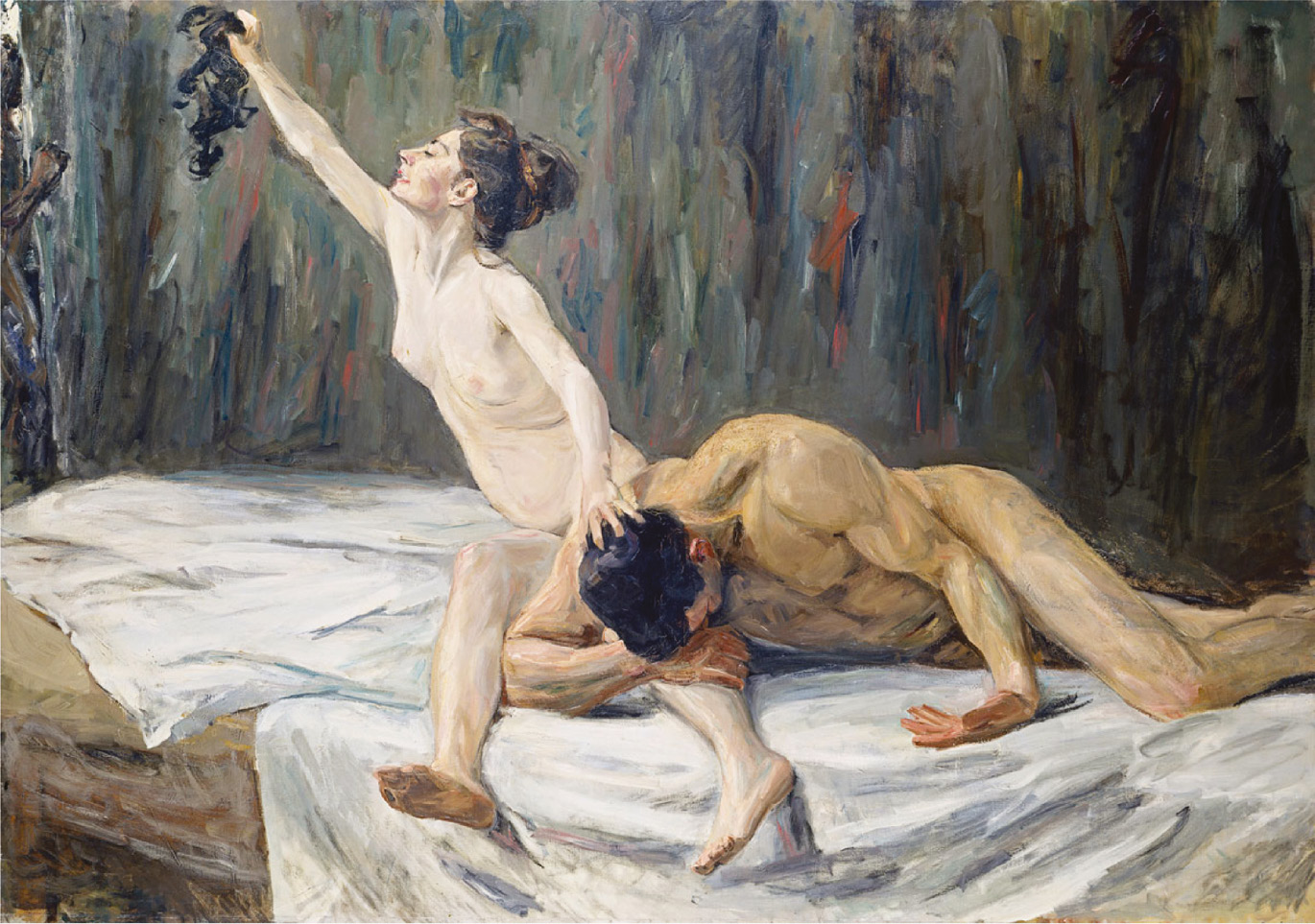Abstract
Delilah is one of the more enigmatic characters in the Hebrew Scriptures. She is marked by a series of ambiguities in the text that pose a host of unanswered questions. Is she a Philistine, an Israelite, or something else? What exactly does her name mean and what is the nature of her relationship to Samson? And why does she help the Philistines capture Israel’s notorious strongman? Despite all this ambiguity, much of her reception history is rigidly consistent. The dominant trend is the portrayal of Delilah as the reviled seductress who bedevils Samson. This interpretation was also promulgated among ancient readers of the story such as Josephus and Pseudo-Philo, who identify Delilah not only as a prostitute and a Philistine, but as the wife of Samson. These types of interpretive gap-filling serve as early exemplars of a long and nearly unwavering reception history in which Delilah is unequivocally the villain. If there is any other interpretive potential lying dormant in the text, then it is rarely actualized. Building upon the work of contemporary feminist and womanist scholars, I intend to subvert that trend by arguing that Delilah can and should be read in a variety ways due to the intentional ambiguity employed by the biblical author. Furthermore, by drawing upon the work of Mikhail Bakhtin, I will identify the “unfinalizability” of Delilah’s character and demonstrate how she simultaneously embodies the role of victim, victor, and villain.
Appendix

Cecil B. DeMille, Samson and Delilah (1949). Paramount Pictures.

Joseph Solomon Joseph, Samson (1887), oil on canvas, 244×366 cm, Walker Art Gallery, Liverpool. National Museums Liverpool.

Max Liebermann, Samson and Delilah (1902), oil on canvas, 147×213 cm, Städtische Galerie im Städelschen, Frankfurt am Main.
Works Cited
Ackerman, Susan. 1998. Warrior, Dancer, Seductress, Queen – Women in Judges and Biblical Israel. Anchor Bible Reference Library. New York: Double Day.Suche in Google Scholar
Ackerman, Susan. 2000. “What if Judges Had Been Written by a Philistine?” Biblical Interpretation 8: 33–41.10.1163/156851500750119042Suche in Google Scholar
Alter, Robert. 2013. Ancient Israel – The Former Prophets: Joshua, Judges, Samuel, and Kings. New York: W.W. Norton and Company.Suche in Google Scholar
Auerbach, Erich. 1953. Mimesis: The Representation of Reality in Western Literature. Translated by Willard R. Trask. Princeton: Princeton University Press.Suche in Google Scholar
Baker, Robin. 2016. Hollow Men, Strange Women – Riddles, Codes and Otherness in the Book of Judges. Biblical Interpretation Series 143. Leiden: Brill.10.1163/9789004322677Suche in Google Scholar
Bakhtin, Mikhail. 1981. The Dialogic Imagination, edited by Michael Holquist and translated by Caryl Emerson and Michael Holquist. Austin: University of Texas Press.Suche in Google Scholar
Bakhtin, Mikhail. 1984. Problems of Dostoevsky’s Poetics, edited and translated by Caryl Emerson. Minneapolis: University of Minnesota Press.10.5749/j.ctt22727z1Suche in Google Scholar
Bal, Mieke. 1987. Lethal Love – Feminist Literary Readings of Biblical Love Stories. Indiana Studies in Biblical Literature. Bloomington: Indiana University Press.Suche in Google Scholar
Bal, Mieke. 1988. Death & Dissymmetry – The Politics of Coherence in the Book of Judges. Chicago: University of Chicago Press.Suche in Google Scholar
Beal, Timothy. 2011. “Reception History and Beyond: Toward the Cultural History of Scriptures.” Biblical Interpretation 19: 357–72.10.1163/156851511X595530Suche in Google Scholar
Begg, Christopher T. 2005. Flavius Josephus: Translation and Commentary, vol. 4. Judean Antiquities 5–7. Leiden: Brill.Suche in Google Scholar
Bledstein, Adrien Janis. 1993. “Is Judges a Woman’s Satire of Men Who Play God?” In A Feminist Companion to Judges, edited by Athalya Brenner, 34–54. Feminist Companion to the Bible 4. Sheffield: JSOT Press.Suche in Google Scholar
Blyth, Caroline. 2017. Reimagining Delilah’s Afterlives as Femme Fatale: The Lost Seduction. Library of Hebrew Bible/Old Testament Studies 652. London: T&T Clark.10.5040/9780567673145Suche in Google Scholar
Breed, Brennan W. 2012. “Nomadology of the Bible: A Processual Approach to Biblical Reception History.” In Biblical Reception 1, edited by J. Cheryl Exum and David J. A. Clines, 299–320. Sheffield: Sheffield Phoenix.Suche in Google Scholar
Breed, Brennan W. 2014. Nomadic Text: A Theory of Biblical Reception History. Indiana Studies in Biblical Literature. Bloomington: Indiana University Press.Suche in Google Scholar
Breed, Brennan W. 2015. “What Can a Text Do? Reception History as an Ethology of the Biblical Text.” In Reception History and Biblical Studies: Theory and Practice, edited by Emma England and William John Lyons, 95–110. Library of Hebrew Bible/Told Testament Studies 615. London: T&T Clark.Suche in Google Scholar
Brettler, Marc Z. 1989. “The Book of Judges: Literature as Politics.” Journal of Biblical Literature 108: 395–418.10.2307/3267111Suche in Google Scholar
Brooke, George J. 2000. “Rewritten Bible.” In Encyclopedia of the Dead Sea Scrolls, vol. 2, edited by Lawrence H. Schiffman and James C. VanderKam, 777–781. Oxford: Oxford University Press.Suche in Google Scholar
Bunimovitz, Shlomo, and Zvi Lederman. 2017. “Swing on the ‘Sorek Seesaw’: Tel Beth-Shemesh and the Sorek Valley in the Iron Age.” In The Shephelah during the Iron Age–Recent Archaeological Studies, edited by Oded Lipschits and Aren M. Maeir, 27–43. Winona Lake, Indiana: Eisenbrauns.10.5325/j.ctv1bxh4cw.5Suche in Google Scholar
Butler, Trent. 2009. Judges. Word Bible Commentary 8. Nashville: Thomas Nelson.Suche in Google Scholar
Clanton, Dan W., Jr. 2009. “Trollops and Temptresses.” In Disreputable and Devout: Interpreting the Hebrew Bible’s Women in the Arts and Music, 65–78. London: T&T Clark.Suche in Google Scholar
Clark, Katerina, and Michael Holquist. 1984. Mikhail Bakhtin. Cambridge: Harvard University Press.Suche in Google Scholar
Crowell, Bradley L. 2013. “Good Girl, Bad Girl: Foreign Women of the Deuteronomistic History in Postcolonial Perspective.” Biblical Interpretation 21: 1–18.10.1163/15685152-1049A0001Suche in Google Scholar
Eisenbaum, Pamela Michelle. 1997. The Jewish Heroes of Christian History: Hebrews 11 in Literary Context. Society of Biblical Literature Dissertation Series 156. Atlanta: SBL Press.Suche in Google Scholar
Exum, J. Cheryl. 1990. “The Center Cannot Hold: Thematic and Textual Instability in Judges.” Catholic Biblical Quarterly 52: 410–431.Suche in Google Scholar
Exum, J. Cheryl. 1993. “Samson’s Women.” In Fragmented Women: Feminist (Sub)versions of Biblical Narratives, 61–93. Journal for the Study of the Old Testament Supplement Series 163. Sheffield: Sheffield Academic Press.Suche in Google Scholar
Exum, J. Cheryl. 1996. “Why, Why, Why, Delilah?” In Plotted, Shot, and Painted: Cultural Representations of Biblical Women, 175–237. Journal for the Study of the Old Testament Supplement Series 215. Gender, Culture, Theory 3. Sheffield: Sheffield Academic Press.Suche in Google Scholar
Exum, J. Cheryl. 2002. “Lethal Woman 2: Reflections on Delilah and Her Incarnation as Liz Hurley.” In Borders, Boundaries and the Bible, edited by Martin O’Kane, 254–273. Journal for the Study of the Old Testament Supplement Series 313. London: Sheffield Academic Press.Suche in Google Scholar
Exum, J. Cheryl. 2007. “Whose Interests Are Being Served?” In Judges & Method – New Approaches in Biblical Studies, 2nd ed., edited by Gale A. Yee, 65–89. Minneapolis: Augsburg Fortress.Suche in Google Scholar
Fakasiieki, Ilkani Latu. 2015. “Delilah: A Postcolonial Discourse Reading of Judg 16:4–22.” PhD diss., Graduate Theological Union.Suche in Google Scholar
Feldman, Louis H. 1988. “Josephus’ Version of Samson.” Journal for the Study of Judaism 19: 171–214.10.1163/157006388X00246Suche in Google Scholar
Feldman, Louis H. 1998. Josephus’s Interpretation of the Bible. Berkeley: University of California Press.Suche in Google Scholar
Franke, John R., ed. 2005. Ancient Christian Commentary on Scripture. Old Testament IV: Joshua, Judges, Ruth, 1–2 Samuel. Downers Grove, Illinois: InterVarsity.Suche in Google Scholar
Fuchs, Esther. 2000. Sexual Politics in the Biblical Narrative: Reading the Hebrew Bible as a Woman. Journal for the Study of the Old Testament Supplement Series 310. Sheffield: Sheffield Academic Press.Suche in Google Scholar
Fuchs, Esther. 2016. Feminist Theory and the Bible – Interrogating the Sources. Feminist Studies and Sacred Texts. Lanham, MA: Lexington Books.Suche in Google Scholar
Gadamer, Hans-Georg. 2013. Truth and Method. Translated by Joel Weinsheimer and Donald G. Marshall. Bloomsbury Revelations. London: Bloomsbury.Suche in Google Scholar
Gafney, Wil. 2016. “A Womanist Midrash of Delilah: Don’t Hate the Playa Hate the Game.” In Womanist Interpretations of the Bible – Expanding the Discourse, edited by Gay L. Byron and Vanessa Lovelace, 49–72. Semeia Studies 85. Atlanta: SBL Press.10.2307/j.ctt1h1htgx.7Suche in Google Scholar
Green, Barbara. 2000. Mikhail Bakhtin and Biblical Scholarship: An Introduction. Semeia Studies 38. Atlanta: SBL Press.Suche in Google Scholar
Green, Barbara. 2005. “Bakhtin and the Bible: A Select Bibliography.” Perspectives in Religious Studies 32: 339–345.Suche in Google Scholar
Greenberg, Lynne A. 2002. “Dalila’s ‘Feminine Assaults’: The Gendering and Engendering of Crime in Samson Agonistes.” In Altering Eyes – New Perspectives on Samson Agonistes, edited by Mark R. Kelley and Joseph Wittreich, 192–219. Newark: University of Delaware Press.Suche in Google Scholar
Gunn, David M. 2005. Judges. Blackwell Bible Commentaries. Oxford: Blackwell.Suche in Google Scholar
Hackett, Jo Ann. 1998. “‘There Was No King in Israel’ – The Era of the Judges.” In The Oxford History of the Biblical World, edited by Michael D. Coogan, 177–218. Oxford: Oxford University Press.Suche in Google Scholar
Harrington, Daniel J. 1971. “The Biblical Text of Pseudo-Philo’s Liber Antiquitatum Biblicarum.” Catholic Biblical Quarterly 33: 1–17.Suche in Google Scholar
Harrington, Daniel J. 1985. “Pseudo-Philo.” In The Old Testament Pseudepigrapha, vol. 2, edited by James H. Charlesworth, 297–377. Garden City: Doubleday & Company.10.5040/9780300261912-0296Suche in Google Scholar
Harrington, Daniel J. 1986. “Palestinian Adaptations of Biblical Narratives and Prophecies I: The Bible Rewritten (Narratives).” In Early Judaism and Its Modern Interpreters, edited by Robert A. Kraft and George W. E. Nickelsburg, 239–247. The Bible and Its Modern Interpreters 2. Atlanta: Scholars Press.Suche in Google Scholar
Houtman, Cornelis. 2014. “Who Cut Samson’s Hair? The Interpretation of Judges 16:19a Reconsidered.” In Samson: Hero or Fool? The Many Faces of Samson, edited by Erik Eynikel and Tobias Nicklas, 67–86. Themes in Biblical Narrative 17. Leiden: Brill.10.1163/9789004262362_006Suche in Google Scholar
Jackson, Melissa A. 2012. “Delilah.” In Comedy and Feminist Interpretation of the Hebrew Bible – A Subversive Collaboration, 116–141. Oxford: Oxford University Press.10.1093/acprof:oso/9780199656776.003.0007Suche in Google Scholar
Jacobson, Howard. 1996. A Commentary on Pseudo-Philo’s Liber Antiquitatum Biblicarum, with Latin Text and English Translation. Arbeiten zur Geschichte des antiken Judentums und des Urchristentums 31. Two Volumes. Leiden: Brill.10.1163/9789004332898Suche in Google Scholar
Jauss, Hans Robert. 1982. “Literary History as a Challenge to Literary Theory.” In Toward an Aesthetic of Reception, translated by Timothy Bahti, 3–45. Minneapolis: University of Minnesota Press.10.2307/468585Suche in Google Scholar
Jonquiere, Tessel M. 2014. “Of Valour and Strength: The Samson Cycle in Josephus’ work: Jewish Antiquities 5.276–317.” In Samson: Hero or Fool? The Many Faces of Samson, edited by Erik Eynikel and Tobias Nicklas, 119–128. Themes in Biblical Narrative 17. Leiden: Brill.10.1163/9789004262362_009Suche in Google Scholar
Junior, Nyasha. 2015. An Introduction to Womanist Biblical Interpretation. Louisville: Westminster John Knox.Suche in Google Scholar
Klein, Lillian R. 1988. The Triumph of Irony in the Book of Judges. Journal for the Study of the Old Testament Supplement Series 68. Sheffield: Almond Press.Suche in Google Scholar
Kozlovic, Anton. 2010. “The Construction of Samson’s Three Lovers in Cecil B. DeMille’s Technicolor Testament, Samson and Delilah (1949).” Women in Judaism a Multidisciplinary Journal 7: 1–31.Suche in Google Scholar
Leneman, Helen. 2000. “Portrayals of Power in the Stories of Delilah and Bathsheba: Seduction in Song.” In Culture, Entertainment and the Bible, edited by George Aichele, 139–155. Journal for the Study of the Old Testament Supplement Series 309. Sheffield: Sheffield Academic Press.Suche in Google Scholar
Llewellyn-Jones, Lloyd. 2005. “The Fashioning of Delilah: Costume Design, Historicism and Fantasy in Cecil B. DeMille’s Samson and Delilah (1949).” In The Clothed Body in the Ancient World, edited by Liza Cleland, Mary Harlow, and Lloyd Llewellyn-Jones, 14–29. Oxford: Oxbox Books.10.2307/j.ctt1w0dcp5.7Suche in Google Scholar
Machiela, Daniel A. 2010. “Once More, with Feeling: Rewritten Scripture in Ancient Judaism – A Review of Recent Developments.” Journal of Jewish Studies 61: 308–320.10.18647/2966/JJS-2010Suche in Google Scholar
Mafico, Temba L. 2007. J. Yahweh’s Emergence as “Judge” among the Gods: A Study of the Hebrew Root špṭ. Lewiston, New York: Mellen.Suche in Google Scholar
Miller, Irit. 2009. “Samson by Solomon J. Solomon: Victorian Academy and Jewish Identity.” Jewish Historical Studies 42: 121–138.Suche in Google Scholar
Mobley, Gregory. 2006. Samson and the Liminal Hero in the Ancient Near East. Library of Hebrew Bible/Old Testament Studies 453. London: T&T Clark.Suche in Google Scholar
Morson, Gary Saul, and Caryl Emerson. 1990. Mikhail Bakhtin – Creation of a Prosaics. Stanford: Stanford University Press.10.1515/9780804765961Suche in Google Scholar
Murphy, Frederick J. 1988. “Retelling the Bible: Idolatry in Pseudo-Philo.” Journal of Biblical Literature 107: 275–287.10.2307/3267700Suche in Google Scholar
Murphy, Frederick J. 1993. Pseudo-Philo – Rewriting the Bible. Oxford: Oxford University Press.10.1093/oso/9780195076226.001.0001Suche in Google Scholar
Newsom, Carol A. 1996. “Bakhtin, the Bible, and Dialogic Truth.” Journal of Religion 76: 290–306.10.1086/489793Suche in Google Scholar
Niditch, Susan. 1990. “Samson as Culture Hero, Trickster, and Bandit: The Empowerment of the Weak.” Catholic Biblical Quarterly 52: 608–624.Suche in Google Scholar
Niditch, Susan. 1996. Oral World and Written Word: Ancient Israelite Literature. Library of Ancient Israel. Louisville: Westminster John Knox.Suche in Google Scholar
Niditch, Susan. 2008. Judges: A Commentary. Old Testament Library. Louisville: Westminster John Knox.Suche in Google Scholar
Niditch, Susan. 2008. ‘My Brother Esau is a Hairy Man’ – Hair and Identity in Ancient Israel. Oxford: Oxford University Press.10.1093/acprof:oso/9780195181142.001.0001Suche in Google Scholar
Niditch, Susan. 2009. “Judges, Kingship, and Political Ethics: A Challenge to the Conventional Wisdom.” In Thus Says the Lord – Essays on the Former and Latter Prophets in Honor of Robert R. Wilson, edited by John J. Ahn and Stephen L. Cook, 59–70. The Library of Hebrew Bible/Old Testament Studies 502. London: T&T Clark.Suche in Google Scholar
Nikolsky, Ronit. 2014. “Rabbinic Discourse about Samson: Continuity and Change between the Tannaitic Culture to the Amoraic.” In Samson: Hero or Fool? The Many Faces of Samson, edited by Erik Eynikel and Tobias Nicklas, 101–118. Themes in Biblical Narrative 17. Leiden: Brill.10.1163/9789004262362_008Suche in Google Scholar
Noegel, Scott B. 2017. “Evil Looms: Delilah – Weaver of Wicked Wiles.” Catholic Biblical Quarterly 79: 187–204.10.1353/cbq.2017.0041Suche in Google Scholar
Parris, David Paul. 2009. Reception Theory and Biblical Hermeneutics. Princeton Theological Monograph Series 107. Eugene, Oregon: Pickwick.Suche in Google Scholar
Petersen, Anders K. 2007. “Rewritten Bible as a Borderline Phenomenon – Genre, Textual Strategy, or Canonical Anachronism?” In Flores Florentino: Dead Sea Scrolls and Other Early Jewish Studies in Honour of Florentino García Martínez, edited by Anthony Hilhorst, Émile Puech, and Eibert Tigchelaar, 285–306. Supplements to the Journal for the Study of Judaism 122. Leiden: Brill.10.1163/9789047423096_019Suche in Google Scholar
Polzin, Robert M. 1980. Deuteronomy, Joshua, Judges. Part 1 of Moses and the Deuteronomist: A Literary Study of the Deuteronomistic History. New York: Seabury.Suche in Google Scholar
Renfrew, Alastair. 2015. Mikhail Bakhtin. New York: Routledge.10.4324/9780203625507Suche in Google Scholar
Ressos, Xenia. 2014. Samson und Delila in der Kunst von Mittelalter und Früher Neuzeit. Petersberg: Michal Imhof.Suche in Google Scholar
Richardson, Brenda E., and Norman Vance. 1992. “Delilah.” In A Dictionary of Biblical Tradition in English Literature, edited by David Lyle Jeffrey, 193–194. Grand Rapids: Eerdmans.Suche in Google Scholar
Ricœur, Paul. 1976. Interpretation Theory: Discourse and the Surplus of Meaning. Fort Worth: Texas Christian University Press.Suche in Google Scholar
Roncace, Mark. 2004. “Another Portrait of Josephus’ Portrait of Samson.” Journal for the Study of Judaism 35: 185–207.10.1163/157006304773787474Suche in Google Scholar
Rowlett, Lori. 2001. “Violent Femmes and S/M: Queering Samson and Delilah.” In Queer Commentary and the Hebrew Bible, edited by Ken Stone, 106–115. Journal for the Study of the Old Testament Supplement Series 334. Sheffield: Sheffield Academic.Suche in Google Scholar
Sasson, Jack M. 1988. “Who Cut Samson’s Hair? (and Other Trifling Issues Raised by Judges 16).” Prooftexts 8: 333–339.Suche in Google Scholar
Scholz, Susanne. 2007. Introducing the Women’s Hebrew Bible. Introductions to Feminist Theologies 13. London: T&T Clark.Suche in Google Scholar
Sharp, Carolyn. 2009. Irony and Meaning in the Hebrew Bible. Indiana Studies in Biblical Literature. Bloomington: Indiana University Press.Suche in Google Scholar
Shütz, Chana C. 1999. “Max Liebermann as a ‘Jewish’ Painter: The Artist’s Reception in His Time.” In Berlin Metropolis – Jews and the New Culture 1890–1918, edited by Emily D. Bilski, 146–163. Berkeley: University of California Press.Suche in Google Scholar
Smith, Carol. 1997. “Samson and Delilah: A Parable of Power?” Journal for the Study of the Old Testament 76: 45–57.10.1177/030908929702207603Suche in Google Scholar
Smith, Carol. 1999. “Delilah: A Suitable Case for (Feminist) Treatment?” In Judges – A Feminist Companion to the Bible, edited by Athalya Brenner, 93–116. Feminist Companion to the Bible 4. Sheffield: Sheffield Academic.Suche in Google Scholar
Snyder, Josey Bridges. 2012. “Delilah and Her Interpreters.” In The Women’s Bible Commentary, 3rd ed., edited by Carol A. Newsom, Sharon H. Ringe, and Jacqueline E. Lapsley, 138–141. Louisville: Westminster John Knox.Suche in Google Scholar
Strawn, Brent A. 2009. “këpîr àrâyôt in Judges 14:5.” Vetus Testamentum 59: 150–158.10.1163/156853308X372946Suche in Google Scholar
Tull, Patricia K. 2019. “Mikhail M. Bakhtin and Dialogical Approaches to Biblical Interpretation.” In Second Wave Intertextuality and the Hebrew Bible, edited by Marianne Grohmann and Hyun Chul Paul Kim, 175–190. Resources for Biblical Study 93. Atlanta: SBL Press.10.2307/j.ctvhn0933.13Suche in Google Scholar
Werner, Alfred. 1964. “The Forgotten Art of Max Liebermann.” Art Journal 23: 214–221.10.1080/00043249.1964.10794526Suche in Google Scholar
Zahn, Molly M. 2010. “Rewritten Scripture.” In The Oxford Handbook of the Dead Sea Scrolls, edited by Timothy H. Lim and John J. Collins, 323–336. Oxford: Oxford University Press.10.1093/oxfordhb/9780199207237.003.0014Suche in Google Scholar
Zahn, Molly M. 2012. “Genre and Rewritten Scripture: A Reassessment.” Journal of Biblical Literature 131: 271–288.10.2307/23488225Suche in Google Scholar
Zwick, Reinhold. 2014. “Obsessive Love: Samson and Delilah Go to the Movies.” In Samson: Hero or Fool? The Many Faces of Samson, edited by Erik Eynikel and Tobais Nicklas, 211–235. Themes in Biblical Narrative 17. Leiden: Brill.10.1163/9789004262362_015Suche in Google Scholar
©2019 Walter de Gruyter GmbH, Berlin/Boston

